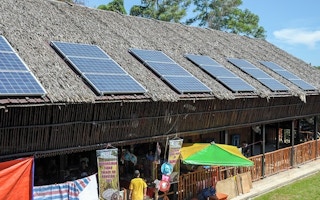A silver lining of global warming is that it is forcing every nation to rethink its future, to open its mind to new possibilities. The latest IPCC report gives the world only 12 years to radically cut greenhouse gas emissions or condemn future generations to climate change catastrophe. There is no choice but to act.
For developed and developing countries alike, this shatters old certainties of foreign policy and national development trajectories based on the exploitation and use of fossil fuels. The human death toll and ecosystem and infrastructure collapses worldwide blow away the argument from the fossil fuel industry that it costs too much to change. Inaction is costing us far more.
As a planetary community, we are in a new era, with all the hopes, risks, opportunities, and insecurities that letting go of the past brings.
As the International Renewable Energy Agency (IRENA)’s latest report, A New World, states: “[J]ust as fossil fuels have shaped the geopolitical map over the last two centuries, the energy transformation will alter the global distribution of power, relations between states, the risk of conflict, and the social, economic and environmental drivers of geopolitical instability.”
Malaysia sits at a unique crossroads. Last year’s election was a wake-up call for the powers that be, with more than 60 years of entrenched power coming to an unexpected and abrupt end.
While much of our region, Australia included, slips further into the pockets of fossil fuel interests, Malaysia has the opportunity to position itself as Southeast Asia’s clean energy and renewable industries leader.
The good news is, we are not in totally unchartered waters. For decades new renewable energy technologies and new policy frameworks to roll them out have been tried around the world.
Distributed energy, micro hydro, off-grid and localised grids, pumped hydro storage, rooftop solar, batteries, wind, large scale solar, and energy efficiency are now the most cost-effective, accessible, and environmentally friendly means of electrification, lifting people out of poverty, and reducing emissions.
Surely all a nation committed to addressing global warming has to do is grab what works, modify it for local conditions and culture, and implement it. But in countries like Australia and Malaysia, it is not that simple.
Is it possible for a country rich in fossil fuels and dependent on them for revenue and energy to change direction? Is it possible for governments to stop thinking in terms of centralised mega projects — dams, mines, power stations — and embrace distributed systems?
This is the question I asked myself when I was elected to the Australian Senate in 2004 on a platform of strong action on global warming. Australia had a huge reliance on fossil fuels — coal and gas — both to generate energy at home and as exports. What would it take to change that?
After seven years, in 2011, with the Greens in balance of power, the Australian Parliament passed the Clean Energy Package which, together with the pre-existing Renewable Energy Target of 20 per cent by 2020, put in place a comprehensive framework to transform the way Australians produce and consume energy and manage the land.
Central to the package was a serious price on carbon imposed through an Emissions Trading Scheme. The Renewable Energy Target made certain that there was a regulatory driver for business to take up renewable energy. In the land sector, the Carbon Farming Initiative tackled the need to reduce deforestation and degradation and to improve soil carbon.
“
Government and non-government actors are … looking at how the right moves now will not only put an end to energy poverty in states like Sarawak and Sabah, but can build on the success of existing small-scale distributed energy systems that have emerged at the grassroots.
Ongoing development of the scheme was to be overseen by the Climate Change Authority established to advise the Parliament on appropriate greenhouse gas reduction targets into the future, taking into account the latest science and actions of other countries. The new laws took effect in 2012 and greenhouse gas emissions fell. It was a monumental breakthrough.
But the fossil fuel-vested interests and their big business and media allies — like the Murdoch press — saw the energy transformation as an attack on their share price and profits. They mounted a political campaign based on false ‘cost of living’ arguments and made huge political donations that led to a change of government that saw the carbon price repealed two years later, in 2014.
In spite of these setbacks, the world-leading policy framework had proven itself. It showed that with a price on carbon, emissions fell and new jobs were generated. The Australian Renewable Energy Agency and the Clean Energy Finance Corporation drove massive roll-out of renewable energy at scale across the country and continues to do so.
Australia now has the highest proportion of households with photovoltaic (PV) systems on their roof of any country in the world, in spite of the current government’s hopeless commitment to fossil fuels. The Australian legislation of 2012 is a template for other countries intent on responding to the climate crisis.
How each country responds will not only determine its place in the new global geopolitical order created by the transition from fossil fuels to renewable energy, but will affect its ability to improve the lives of its people and meet its Sustainable Development Goals.
Malaysia is well-positioned to take advantage of the opportunities to transition to a renewable energy economy. Government and non-government actors are already organising for change, looking at how the right moves now will not only put an end to energy poverty in states like Sarawak and Sabah, but can build on the success of existing small-scale distributed energy systems that have emerged at the grassroots, spearheaded by indigenous communities.
I will be joining these groups for the Clean Energy Collaboration Kuching in March to see how we can learn from indigenous land rights activists who have been working on these issues for decades.
New Malaysian leaders at the federal level, such as Yeo Bee Yin, Baru Bian, and Banie Lasimbang, understand the complexities of the situation and are ready to champion projects that bring prosperity to people while addressing environmental concerns.
Malaysia can be a champion for our region. Where it chooses to sit on this spectrum between leader and follower in the new geopolitical relationships evolving from the transition to renewable energy is yet to be seen, but the opportunity to lead in the transformation in Southeast Asia is wide open.
This story was published with permission from Mongabay.com.
Christine Milne has been appointed as the first Global Greens Ambassador, after she was an Australian Senator and leader of the parliamentary caucus of the Australian Greens from 2012 to 2015. Global Greens is an international network of political parties and movements which work to implement the Global Greens Charter.









